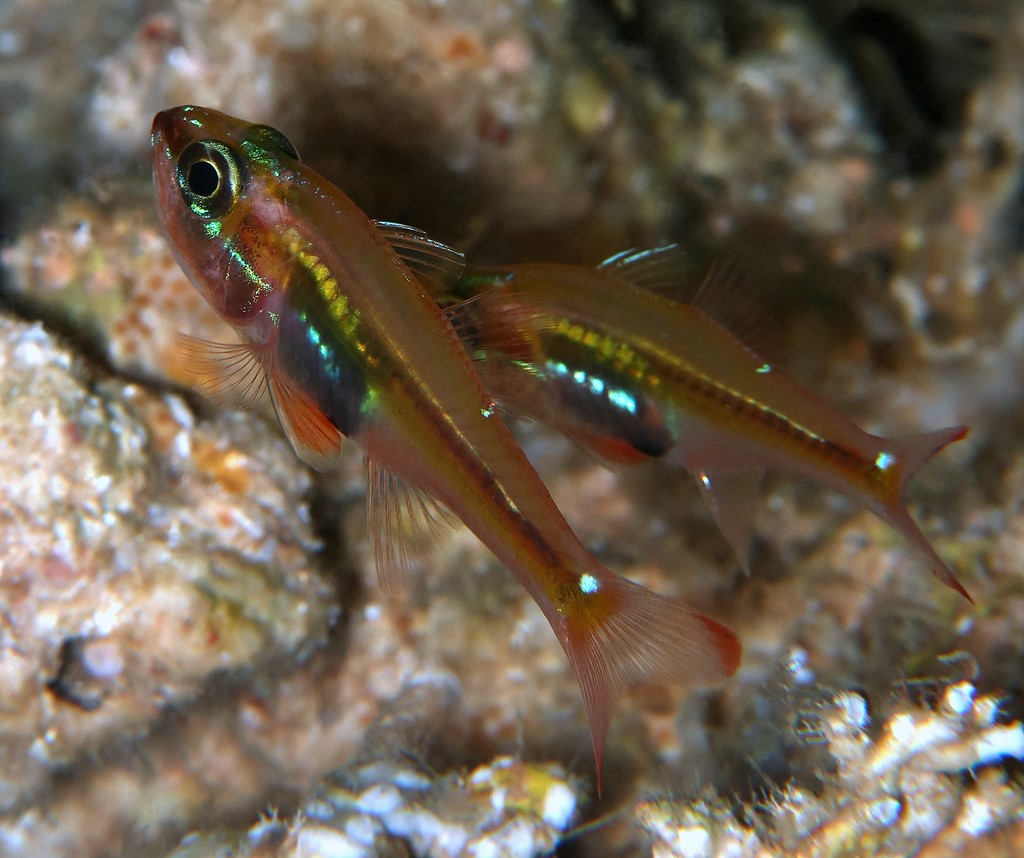OSTORHINCHUS MELANOPROCTUS - (FRASER & RANDALL, 1976)
Picture courtesy of: Alain Daoulas
Actinopterygii (Gigaclass) > Actinopteri (Class) > Teleostei (Subclass) > Gobiiformes (Order) > Apogonoidei (Suborder) > Apogonidae (Family) > Apogoninae (Subfamily) > Ostorhinchus (Genus)
Poisson cardinal à ventre noir, Blackvent cardinalfish,
Synonyme
Apogon melanoproctus (Fraser & Randall, 1976)
------------------------
Description
Dorsal spines (total): 7-8; Dorsal soft rays (total): 9; Anal spines: 2; Anal soft rays: 8-9; Pectoral fin ray: 13-14 (usually: 14); Pelvic fin ray: I, 5; Principal caudal fin rays: 9 + 8; Secondary caudal fin rays: 8-9 above and 8-9 below; Well-developed gillrakers: 22-24 (4-5 + 18-19), including rudiments: 25-27 (2-3 + 4-5; 18-19 + 0-1); Pored lateral line scales: 24; longitudinal row above lateral line 24; Transverse rows above lateral line: 2; Transverse rows below lateral line: 6; Median predorsal row: 5; Circumpeduncular scales: 12 (5-2-5). One row of teeth on dentary; Two or three rows on premaxilla becoming one row on side; Teeth on palatine few or absent; No teeth on vomer, ectopterygoid or endopterygoid; Occasionally teeth on base of basihyal. Vertebrae: 10+14; Basisphenoid present; Supramaxilla absent; 2 predorsals; 2 dorsal spines on the first pterygiophore; 7 epipleural ribs; 5 free hypurals; 3 epurals; 1 pair of uroneurals; Suspensory pharyngeal present; 4 upper pharyngeal tooth patches; 7 branchiostegal rays; No hidden eighth dorsal spine; posttemporal serrated; Preopercular ridge smooth, ventral, and posterior edges serrated; Infraorbitals smooth; Shelf on third infraorbital. Swim bladder with a single bundle and gas gland. Max. length: 4.0 cm SL. Depth range: 15 - 50 m.
Color
Most of body translucent with brownish-orange, black and white markings; Tip of lower jaw brownish-orange; snout and post-ocular region without a well defined stripe, but with some orange pigment; Base of caudal with a brownish-orange bar and a smaller adjacent white spot positioned anterodorsally; Another white spot at base of last dorsal ray; A black area around anus; Cheek and abdomen silvery.
Etymology
Ostorhinchus: from Greek, osteon = bone + from Greek, rhynchos = beak. In reference to the bony jaws, very much advanced and jagged, which take the place of the teeth.
melanoproctus: from Ancien Greek, mélas, mélanos = black + from Greek, proktos = anus. Referring to black pigment that completely surrounds anus.
Original description: Apogon melanoproctus Fraser & Randall, 1976 - Type locality: south side of Tanavula Point - Florida Island, Solomon, 09°02'44"S, 160°04'07"E, vertical reef wall with caves, 18-37 m, 30 July 1973, J. E. Randall and G. R. Allen.
Distribution
Western Pacific: Indonesia east to Palau and New Ireland (Papua New Guinea), north to Philippines, south to Solomon Islands and New Caledonia (Koumac).
Biology
Occurs in aggregations in caves in vertical walls. Also found in steep outer reef slopes. Mouthbrooders. Distinct pairing during courtship and spawning.
Similar species
Ostorhinchus dispar (Fraser & Randall, 1976) - Reported from New Caledonia - Link to the species (here).
Last update: 22, September 2022
Actinopterygii (Gigaclass) > Actinopteri (Class) > Teleostei (Subclass) > Gobiiformes (Order) > Apogonoidei (Suborder) > Apogonidae (Family) > Apogoninae (Subfamily) > Ostorhinchus (Genus)
Poisson cardinal à ventre noir, Blackvent cardinalfish,
Synonyme
Apogon melanoproctus (Fraser & Randall, 1976)
------------------------
Description
Dorsal spines (total): 7-8; Dorsal soft rays (total): 9; Anal spines: 2; Anal soft rays: 8-9; Pectoral fin ray: 13-14 (usually: 14); Pelvic fin ray: I, 5; Principal caudal fin rays: 9 + 8; Secondary caudal fin rays: 8-9 above and 8-9 below; Well-developed gillrakers: 22-24 (4-5 + 18-19), including rudiments: 25-27 (2-3 + 4-5; 18-19 + 0-1); Pored lateral line scales: 24; longitudinal row above lateral line 24; Transverse rows above lateral line: 2; Transverse rows below lateral line: 6; Median predorsal row: 5; Circumpeduncular scales: 12 (5-2-5). One row of teeth on dentary; Two or three rows on premaxilla becoming one row on side; Teeth on palatine few or absent; No teeth on vomer, ectopterygoid or endopterygoid; Occasionally teeth on base of basihyal. Vertebrae: 10+14; Basisphenoid present; Supramaxilla absent; 2 predorsals; 2 dorsal spines on the first pterygiophore; 7 epipleural ribs; 5 free hypurals; 3 epurals; 1 pair of uroneurals; Suspensory pharyngeal present; 4 upper pharyngeal tooth patches; 7 branchiostegal rays; No hidden eighth dorsal spine; posttemporal serrated; Preopercular ridge smooth, ventral, and posterior edges serrated; Infraorbitals smooth; Shelf on third infraorbital. Swim bladder with a single bundle and gas gland. Max. length: 4.0 cm SL. Depth range: 15 - 50 m.
Color
Most of body translucent with brownish-orange, black and white markings; Tip of lower jaw brownish-orange; snout and post-ocular region without a well defined stripe, but with some orange pigment; Base of caudal with a brownish-orange bar and a smaller adjacent white spot positioned anterodorsally; Another white spot at base of last dorsal ray; A black area around anus; Cheek and abdomen silvery.
Etymology
Ostorhinchus: from Greek, osteon = bone + from Greek, rhynchos = beak. In reference to the bony jaws, very much advanced and jagged, which take the place of the teeth.
melanoproctus: from Ancien Greek, mélas, mélanos = black + from Greek, proktos = anus. Referring to black pigment that completely surrounds anus.
Original description: Apogon melanoproctus Fraser & Randall, 1976 - Type locality: south side of Tanavula Point - Florida Island, Solomon, 09°02'44"S, 160°04'07"E, vertical reef wall with caves, 18-37 m, 30 July 1973, J. E. Randall and G. R. Allen.
Distribution
Western Pacific: Indonesia east to Palau and New Ireland (Papua New Guinea), north to Philippines, south to Solomon Islands and New Caledonia (Koumac).
Biology
Occurs in aggregations in caves in vertical walls. Also found in steep outer reef slopes. Mouthbrooders. Distinct pairing during courtship and spawning.
Similar species
Ostorhinchus dispar (Fraser & Randall, 1976) - Reported from New Caledonia - Link to the species (here).
Last update: 22, September 2022
